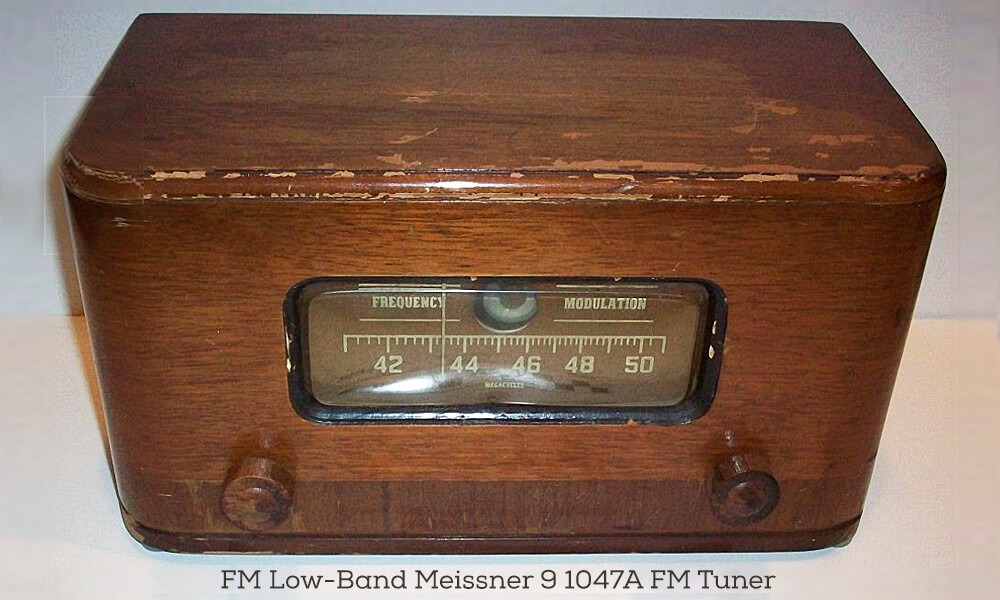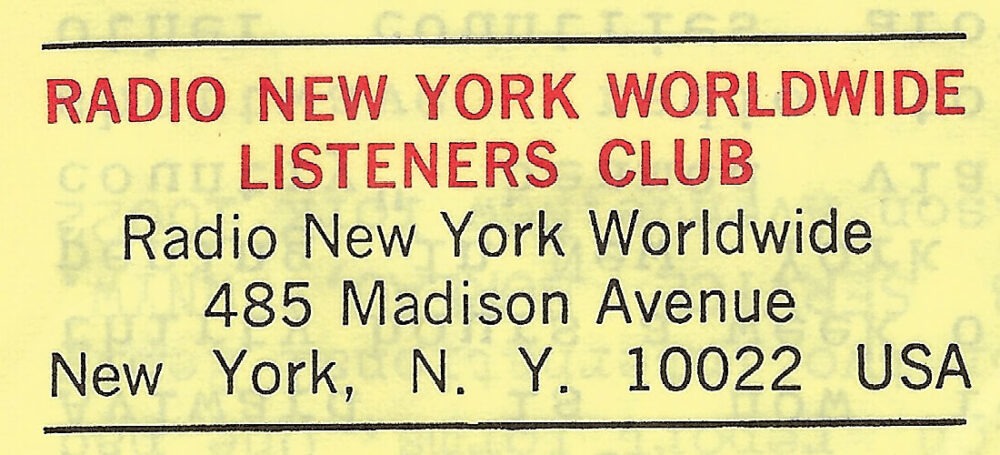Since this story begins with a gentleman named Edwin Howard Armstrong inventing and developing what we commonly call FM Radio, I thought I’d show you what the original FM radio dial looked like. If the numbers on this Meissner tuner do not look familiar, that’s because in the radio wave spectrum where the FM band lives today was not its original home … the Federal Communications Commission (FCC) moved it immediately following the end of World War Two. Reason for the move is another story, with most believing the change was harmful to FM’s growth as a viable radio service. My personal opinion is — while it may have slowed its blossoming — that the move was positive … as the new space provided for nearly twice as many stations as would have fit in the original allocation — take a look at the shortness of the dial!
After I say thanks to Brian Belanger, who is curator of the National Capital Radio & Television Museum in Bowie, Maryland, for providing this photo … the headline above references the article below which yours truly wrote in 1970 while I was General Manager of WRFM in New York City. It was written at the request of the editor of the Radio New York Worldwide Listeners Club newsletter. You say what? Radio New York Worldwide was an international shortwave station sister to WRFM, which offered English and Spanish language programming to listeners on the continents of Africa, Europe and South America. (We’ll leave the rest of this story for another Musings which I’ll try to put together one day soon.)
It’s taken almost thirty years for frequency modulation (FM) to really make it. First it was in the United States, later the entire world.
The first FM radio station began broadcasting with regular programming from a place called Alpine, New Jersey, just across the Hudson River from New York City. Edwin Armstrong had finally realized his dream of providing a superior form of aural broadcasting whose qualities are still basically unsurpassed, even today.
Major Armstrong began working on the development of the frequency modulation system of transmitting radio signals in 1928 and finally obtained its basic circuit patents in 1933. The intervening years between 1934, when his major development and testing work was completed and 1938, were committed to gaining acceptance for this new method of broadcasting.
Armstrong had come up with a truly revolutionary mode of broadcasting but found little interest and much opposition from the broadcast industry, the industrial concerns involved in receiver manufacture, and even the engineering staff of the United States Federal Communications Commission. He then decided to construct his own high-powered station to demonstrate the special qualities of FM broadcasting: superior fidelity and an almost complete immunity to interference.
At about this time, Armstrong and FM gained the attention and interest of two New England broadcasters, who decided to construct FM stations of their own. The Yankee Network, built on a mountaintop at Worcester, Massachusetts and Franklin Doolittle, owner of WDRC in Hartford, Connecticut, constructed on West Peak at Meriden, Connecticut. These stations both went on the air in the late summer of 1939, a few months after Major Armstrong’s W2XMN at Alpine. The stations held only experimental licenses as it would be another two years before the Federal Communications Commission would establish FM broadcast standards and grant the first commercial license … just in time for World War II to put a crimp on the manufacture of transmitting equipment. Major Armstrong never did obtain a commercial license for his Alpine station and after his death in 1954, it ceased broadcasting … but the Doolittle station at Meriden remains today as the oldest FM station in the country. (The Worcester, Massachusetts, station went off the air in the late forties when the Yankee Network changed ownership.) Still maintaining its complete studio and transmitting operations in the stone ski-lodge style building built for it, the station today bears the call letters WHCN. Its location, which did not have commercial power or telephone service until 1944, is still remote enough for station announcers to be snowed in for three days during a recent winter’s storm and for an occasional snake to slither through the studio. Today the building also houses the transmitter of WLAE (FM), also licensed to Hartford. This unit has played its own role in the history of FM – it is one of the original transmitters built for the new band when FM broadcasting in the United States moved to the higher frequencies of 88-108 MHz in 1945. It served the Doolittle station for nearly fifteen years before going into service for WLAE a decade ago.

As for Mr. Doolittle’s pioneering station, its seen changes in programming emphasis during its thirty-year history, as has the FM industry throughout the United States. For most of its first 25 years, its principal format included classical music, including live broadcasts of the Hartford Symphony Orchestra. In the middle sixties it was transformed into a popular music station in an attempt to achieve a degree of monetary success. A few months ago, it changed formats again and. has become Connecticut’s first and only “underground” or progressive rock music station.
This is pretty much how FM radio has gone over the years in the USA. Overshadowed in its efforts to gain stature by the “radio with pictures” medium of television, the only station operators who put much effort into programming their stations — other than for a brief period in the late forties — were the classical music devotees. Many in this group were engineers, who placed their emphasis on perfect reproduction of sound. Many of these devotees felt that this was the only kind of music worthy of all the special equipment and effort. So, when receivers became available, you had no need to buy one unless you liked classical music. In the late fifties, young people desiring to enter broadcasting found opportunities for rapid growth were not to be had in AM radio and were rapidly disappearing from the television branch of the medium. So they turned their energies toward FM, where the number of station licenses were dwindling every year since hitting a peak in 1949.
A prime example of this new talent was James Gabbert and Gary Gielow, two Stanford University students who established KPEN (now KIOI) in an adobe shack on a mountain top outside San Francisco, California. It was a two-man operation with everyone (all two) doing everything from engineering to promotion, announcing to sales. They worked hard and played more than just classical music, in fact, they played just about every type of music available instead of the usual classical. Ten years later this station continues to be one of the most successful FM operations in the country.
In 1965 a new musical style first appeared on the US scene — progressive rock, or as it was called, “underground” music. The first radio station to adapt its format to this new music of the ‘hip’ young adult generation was station KMPX in ‘hip’ San Francisco. This FM station proved that it could build a loyal following with this programming and soon was also doing quite well with advertisers. Following suit in the summer of 1966, WOR-FM in New York City separated from its highly successful AM sister station and began playing the progressive recordings that were accounting for more and more record album sales in stores. WOR-FM found even greater success than KMPX had achieved, but within a year dropped progressive rock in favor of what has proven even more of a revenue and ratings builder for it, regular contemporary rock music.
Meanwhile, WNEW-FM took over as the “underground” FM station in New York and at least one FM station in almost every city of any size in the United States began playing it at least some of the time. Today, just three years later, progressive rock has firmly established itself as the second most popular and profitable program format in FM radio.
Major Armstrong, who took his own life in despair after two long, hard decades of battles to earn for FM its rightful place in broadcasting, would have been proud of the position FM is finally achieving at the end of the sixties — a position of success and strength that it should have seen 20 years earlier.
And that, my Friends, is how the world of FM radio was 50 years ago!
In the latter part of the article above, I reference the Progressive Rock format as being the “second most popular and profitable program format” on FM … yet did not mention what the most successful one was. Of course, it was the Beautiful Music/Easy Listening format as heard on WRFM, WJIB in Boston and WDVR in Philadelphia, and before long, on at least one FM station in most every city across the land … and that station would quickly become top-rated in listenership among all stations, FM and AM. Related to this: In 1968, industry statistics showed that WDVR was the highest revenue-generating FM station in America, for the first time in history delivering more than one million dollars in annual advertising sales!
Before I close, one final note: In the photo above, this is Edwin Armstrong and his wife Marion, spending an afternoon at the beach — of course, Edwin could not resist bringing along his “portable” radio! Recently, almost laughable … I was watching a PBS documentary, the subject of which I cannot remember but was not in any way related to radio … in the middle of a series of stock photos, up pops this picture!
Thank you, Edwin Howard Armstrong, for the tremendous gift you gave to us and the world. It’s sad that your story did not have a much happier ending. I hope that those who played a significant role in causing your action felt at least some sense of remorse upon hearing the news.
To read more about the life and trials of Major Armstrong and his unique Alpine tower, here’s a great article by Scott Fybush.
Image Credits: Photo: Armstrong and his new wife Esther Marion MacInnis via Wikipedia, Photo: James Gabbert and Gary Gielow. Courtesy of Gary M. Gielow via sfgate.com







Marlin,
Marion Armstrong visited KIRO-FM 100.7 in 1973. If memory serves we added SQ quadraphonic and Dolby FM back then.
Major Armstrong is a childhood hero of mine as so much of our current technology was envisioned and or invented by the Major.
Mrs. Armstrong gave me a paperback, "Man of High Fidelity," his biography. It has a cherished place on my den bookshelf, next to your book.
Thanks, Claude. Never heard about Mrs. Armstrong’s visit.